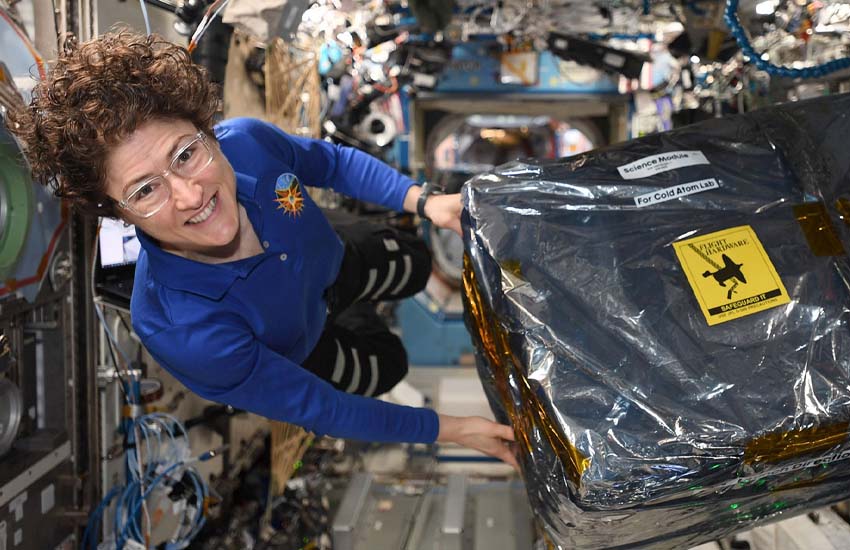
By chilling atom clouds to just above absolute zero – the lowest temperature matter can reach – Cold Atom Lab enables scientists to directly observe unique atomic behaviours, helping answer questions about how our world works at the smallest scales.
The new hardware will dramatically expand Cold Atom Lab’s capabilities.
Installing the upgrade in space was something of an experiment as well. On Earth, that task would fall to engineers with years of experience handling the components.
To avoid bringing the facility back down from the space station – a costly and time-consuming step – the mission team guided Koch and Meir through the installation via live video conference from NASA’s Jet Propulsion Laboratory in Southern California.
Kamal Oudrhiri, project manager for Cold Atom Lab at JPL, explained, “With this upgrade, we were effectively replacing the heart of Cold Atom Lab, and everything had to go perfectly.
“Astronauts are extremely smart, capable people, but we felt like heart surgeons trying to show a general practitioner how to do surgery for the first time. We did everything we could to ensure success, but truthfully I was very nervous.”
Physicists use ultracold atom facilities on Earth for a variety of experiments that probe the fundamental behaviours of atoms. Chilling atoms to within one 10-billionth of a degree above zero Kelvin (minus 459.67 degrees Fahrenheit, or minus 273.15 degrees Celsius) causes them to slow down significantly, making them easier to study.
At those temperatures, some atoms can also form a fifth state of matter, called a Bose-Einstein condensate that does not exist in nature.
Bose-Einstein condensates provide a unique window into the strange world of quantum mechanics, which governs the universe at very small scales.
Cold Atom Lab is the first ultracold atom facility in Earth orbit.
In the weightless environment of space, atoms aren’t pulled down by gravity, so they exist in their unbound, ultracool state for long periods of time.
This characteristic enables scientists to observe their natural behaviours in a way that is not possible on Earth.
Five science groups have been conducting experiments with Cold Atom Lab since it began operating in the summer of 2018, and they’re eager to begin working with the upgraded hardware, including a new instrument called an atom interferometer.
In space, atom interferometry could have multiple applications, including making exquisitely subtle measurements of gravity that are useful for fundamental physics research, planetary science and other fields.
For example, atom interferometry could be used to measure changes in gravity across a planet’s surface to learn about its composition and subsurface features.
The tool could also be used to test Albert Einstein’s fundamental theory of gravity to an unprecedented degree. The Cold Atom Lab team recently confirmed that the atom interferometer is working as expected, making it the first instrument of its kind to operate in space.
“With Cold Atom Lab, we’re looking for new physics that pops up only when you can study the universe at extremely fine scales,” said Jason Williams, the lead scientist for the Cold Atom Lab atom interferometer at JPL.
Cold Atom Lab consists of two metal boxes, the larger of which is called the Science Instrument and weighs over 400 pounds (180 kilograms). Inside is a compartment called the Science Module, which is where the atoms are cooled and the science takes place.
To complete the upgrade, Koch and Meir would have to gently maneuver the sizeable Science Instrument out of its operating location on the space station, remove the old Science Module and replace it with the new one.
Months before the installation, members of the Cold Atom Lab team worked with the Payload Operation and Integration Centre at NASA’s Marshal Space Flight Centre in Huntsville, Alabama, to create instructions for Koch and Meir.
They divided the installation into six sessions over eight days, including practice for Koch. Crew time on the station is extremely valuable, so the mission team spent weeks practicing the steps on Earth to optimise the procedure.
Once testing and analysis of the new hardware are complete in the coming weeks, the team expects the science groups that use the Cold Atom Lab to begin taking data again.
Building an ultracold atom facility that could withstand the trip to space, operate with little to no astronaut assistance, and even be upgraded in orbit took the Cold Atom Lab team years. Now they hope their work has kicked off an era in which quantum science is done regularly in orbit.
Designed and built at JPL, Cold Atom Lab is sponsored by the Space Life and Physical Sciences Research and Applications division of NASA’s Human Exploration and Operations Mission Directorate at NASA Headquarters in Washington and the International Space Station Program at NASA’s Johnson Space Centre in Houston.
Receive the latest developments and updates on Australia’s space industry direct to your inbox. Subscribe today to Space Connect here.












